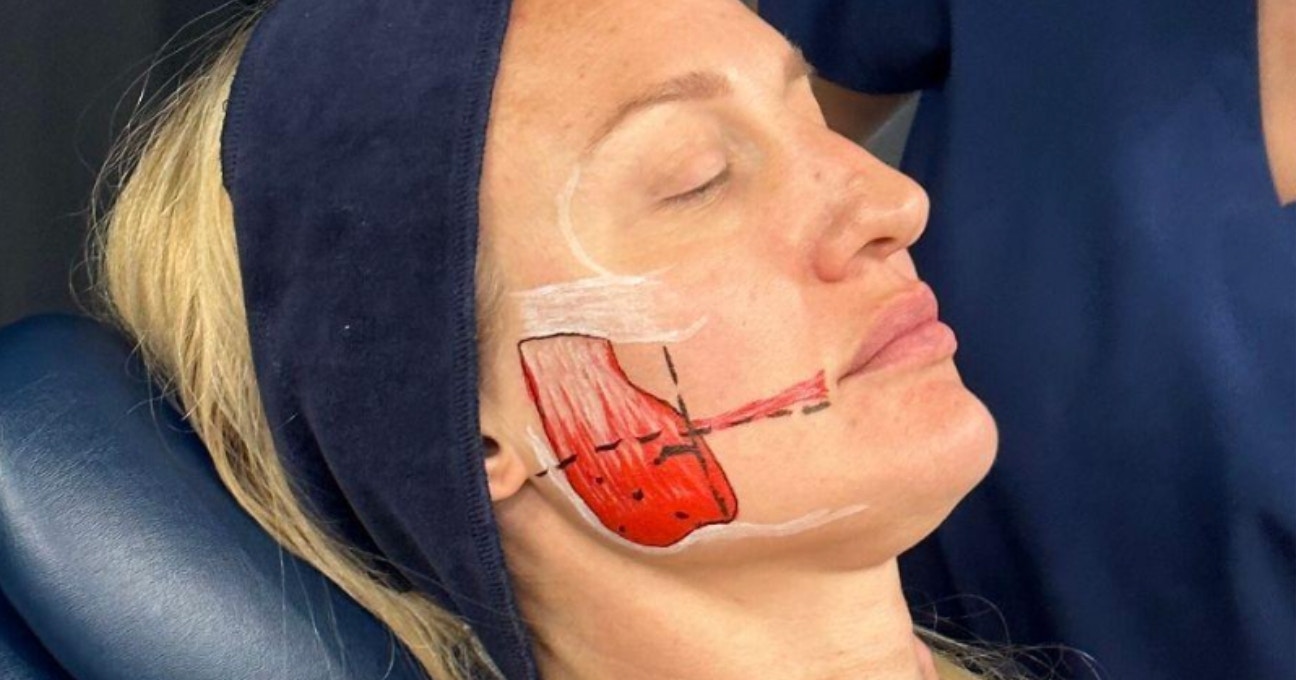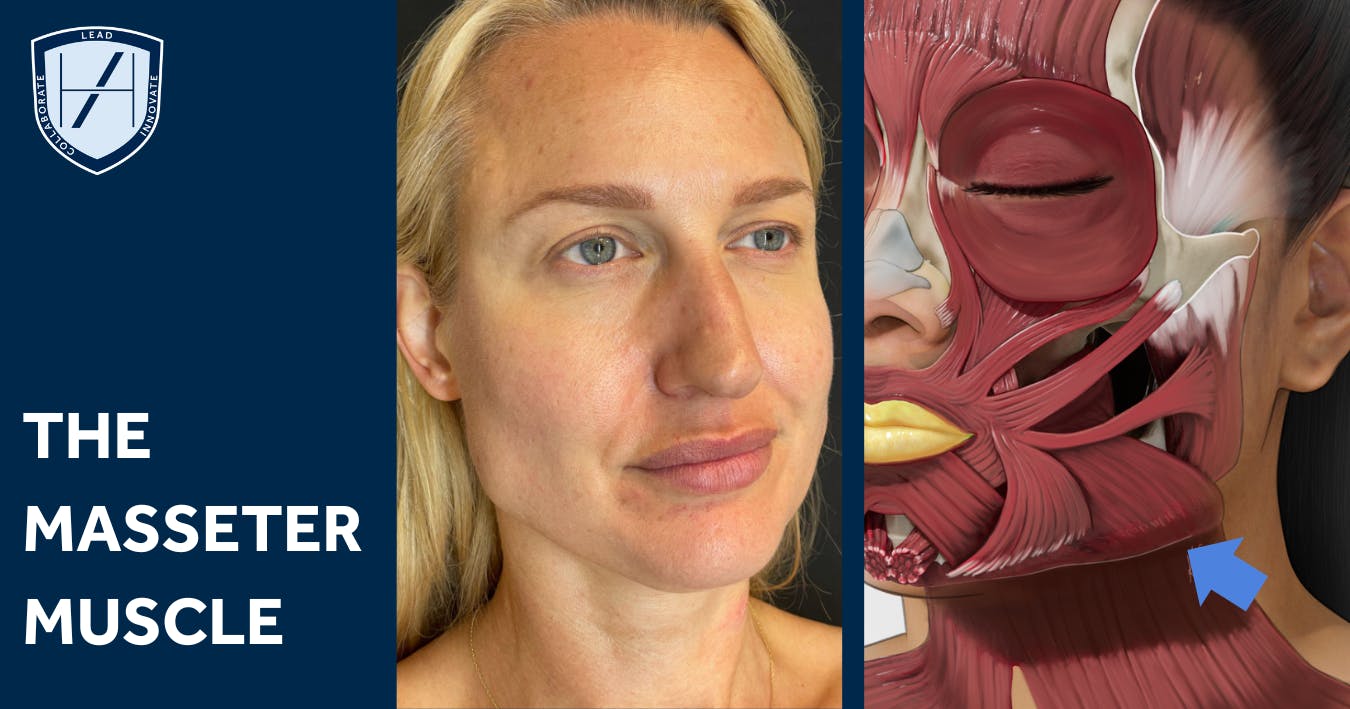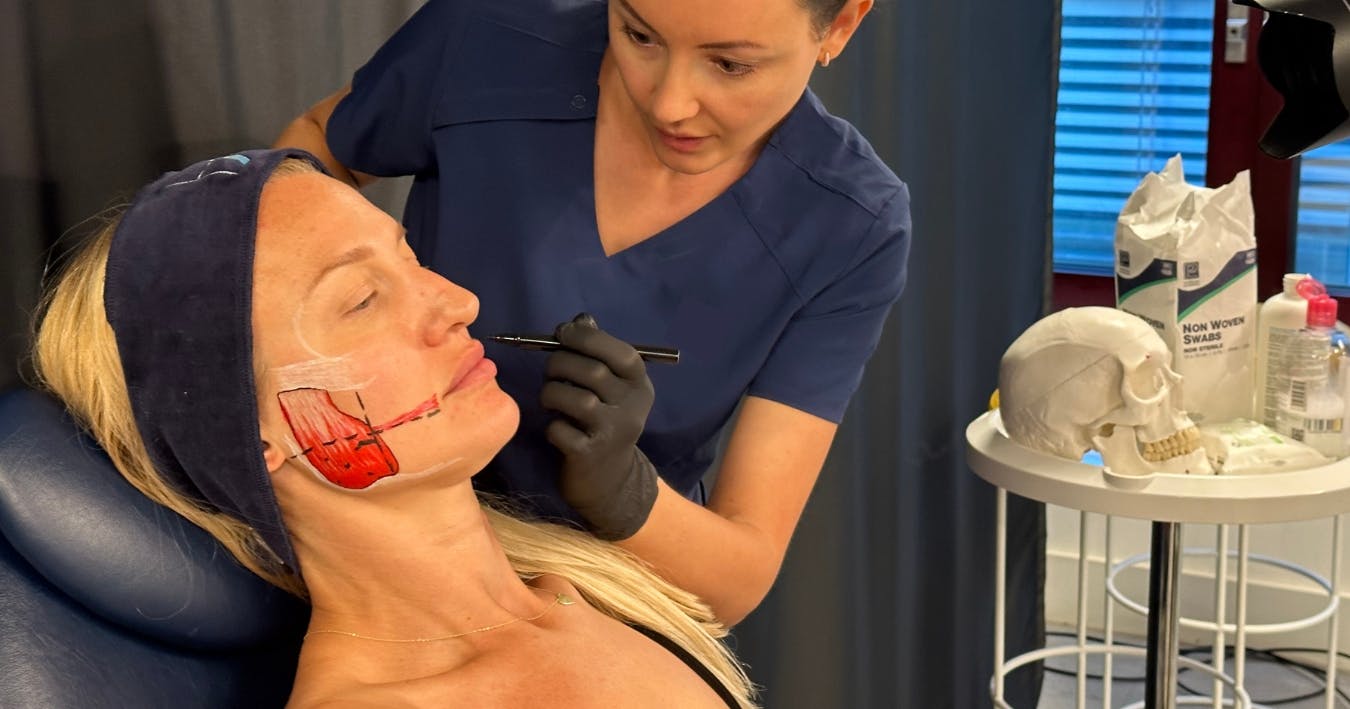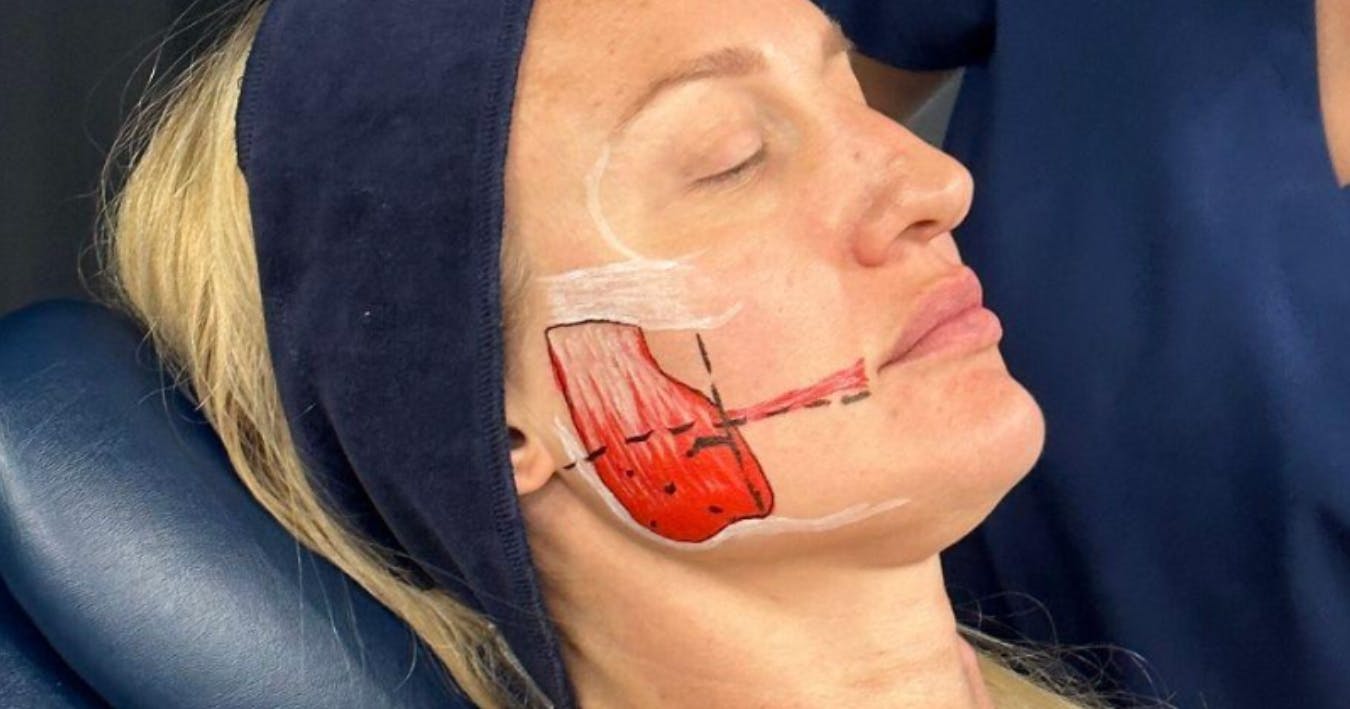Masseter Botox Injection Techniques for Jawline Slimming

Masseter botox is becoming a popular treatment that more and more patients are asking for.
Injected in the lower face for either beautification or medical purposes, Dr Victoria Russell offers her advice and insight into this treatment. A Clinical Trainer at our City of London training academy, she’s also an aesthetics specialist.
Here’s everything you need to know about treating the masseter muscles.
What are the masseters?
The masseter, Dr Victoria explains, “is a large, powerful muscle of mastication or chewing, found on both sides of the face. The muscle extends from the cheekbone down to the angle of the jaw.
“You might be able to see your masseter muscle bulging when you clench your jaw.”
What is masseter botox and why do patients request it?
Dr Victoria shares “Masseter botox is a treatment that involves injections of botulinum toxin into the muscle. This then relaxes and shrinks the muscle over time in a process known as atrophy. Injecting botox here can provide relief from:
- Jaw tension
- Pain
- Clenching
- Teeth grinding, also known as bruxism.
“Another term for masseter botox, generally used by patients and mainstream media is ‘jawline slimming’ treatment. This refers to how masseter botox can reshape the jawline, giving patients with a wide or squared jawline a slimmer, more feminine appearance.”
Is treating the masseters with toxin a cosmetic or medical treatment?
This is how to decide if the treatment you’re administering is medical or cosmetic, on a very basic level:
- Masseter botox for the relief of medical symptoms, as outlined above, is a medical treatment
- Jawline contouring - where you treat the masseters with toxin to provide a slimming effect to these muscles - is a cosmetic treatment.
The question of which category this treatment falls into is a pertinent one for three key reasons.
- If you’re administering botulinum toxin for medical reasons, you will need to be registered with the Care Quality Commission (CQC)
- You’ll need to ensure your insurance covers you for treating based on the relevant indication
- Whether a treatment is considered ‘medical’ or ‘cosmetic’ may affect your VAT.

Why you should take a masseter botox training course
Just because you’ve completed a cosmetic botox course covering upper face applications, that doesn’t mean you can then treat other areas.
When it comes to the jawline, you’re looking at a very different anatomy. Additionally, your technique will need to vary from that used for the standard ‘three area’ toxin treatment.
Furthermore, it’s most likely also required by your insurers. Aesthetics training that covers all areas you offer injectables for is generally mandatory under your insurance cover. However, even where it isn’t, we certainly recommend this for reasons of safety, ethics and patient care.
We’re soon to add to our growing roster of cosmetic dermatology, botox and filler courses with a course that will expand your toxin capabilities. The Advanced Botox Course is designed to fit around your busy schedule and offers training on masseter management, gummy smiles, platysmal bands and more! Not only does this mean you can cater to multiple aesthetic concerns, but it’ll allow you to also attract new patients!
As aesthetics practitioners, your organic advertising occurs through word of mouth. Elevating your practice by offering more advanced treatments, executed well, can increase this!
Which patients are best suited to masseter botox?
“Patients best suited for this treatment have enlarged masseter muscles. This can be easily seen and felt when they clench their jaw. She notes, ’Patients may have a wide or square jawline, but this isn’t always an indication.
"They may also complain of jaw tension, tenderness, or experience teeth clenching and grinding,” Dr Victoria explains.
Which patients are not suitable for this treatment?
Dr Victoria notes that “masseter botox is not for everyone!
“Along with the usual contraindications such as pregnancy, breastfeeding and neuromuscular disorders - masseter botox needs special consideration for patients with skin laxity. In these patients, reducing the volume of the masseter muscle at the angle of the jaw can result in a less defined jawline. This can enhance jowls.
“It’s also important to note that some patients will naturally have a wide or square jawline. They may have an underlying bony structure or fat deposition and masseter botox will not help in these cases.
“A thorough history and examination before any treatment will allow you to determine your patients’ suitability.”
Marking up for masseter botox injection points
Drawing on your injection marks is a great way to map out where to inject, as a medical aesthetics practitioner.
Dr Victoria highlights, “There are various injection techniques used by aesthetic practitioners. These usually range from 3 to 6 equidistant injection points in the masseter.” These points will also take into account toxin spread, to ensure adjacent muscles are not inadvertently affected by treatment.
For patient safety, we advise that, before treating, you cleanse away any landmarks to sterilise the area or inject away from them. Injecting through these pencil marks increases the risk of infection.

How to inject botox in the masseter muscles
“Botox is administered locally into the hypertrophied masseter muscle by perpendicular injections into the muscle bulk. ” Dr Victoria emphasises.
She recommends using a 13mm 30G ½” botox needle for injecting. The masseter is a thick muscle. It is important to treat the deep and superficial aspects of the muscle to prevent paroxysmal muscle spasm after treatment. Some practitioners use a retrograde thread technique for toxin administration to prevent this.
Toxin dosage for men vs women
Dr Victoria states that when assessing patients, their facial anatomy, gender presentation and ethnicity need to be considered. She highlights, “Facial anatomy varies widely between individuals, so aesthetic practitioners must be able to assess each patient’s muscle anatomy. You can ask the patient to clench their jaw or smile and in animation determine the dose.
“When treating a patient for the first time, assess the severity of masseter hypertrophy. Ideally, you’d want to administer 4-8 units of toxin per injection point.”
She stresses, “Remember that with botox you can add, but you can’t take it away. The dosing may vary between genders depending on the desired aesthetic outcome and the severity of the masseter muscle hypertrophy.”
Aftercare advice
An important, yet often overlooked aspect of the appointment process is delivering post-treatment botox aftercare advice effectively. Proper aftercare can help minimise risks of complications and optimise results.
The masseter is a big muscle, so seeing changes in it is a slower process as the muscle atrophies, compared to upper face botox. Advise your patients that it can take anywhere from 5-30 days to see results and the effects should last between 3-6 months. Several factors can impact how long botulinum toxin outcomes last, including if they’ve had treatment before and how many times.
After treatment, patients should be advised that they may find chewing more challenging due to the induced muscle weakness.
Bumps and swelling should subside within a few hours, whereas minor bruising and redness can take a couple of days.
They should also avoid the following for 24 hours after treatment:
- Excessive alcohol
- Makeup
- Ibuprofen
- Facials
- Massages
- Exercise
- Rubbing the area
- Saunas and steam rooms.

Schedule your patients’ review appointments
“After the appropriate period, you should always review your patients after you have administered a treatment. Some patients may require additional units of botox to achieve the desired result,” Dr Victoria advises.
It’s recommended to book these reviews in before they leave the clinic after treatment. That way you both know that it’s in the diary and won’t be missed.
Knowing it’s been proactively scheduled and they don’t have to follow-up with you to arrange can also contribute to a more positive experience.
This small step demonstrates that you know what you’re doing and care about their outcomes and satisfaction. It can also be comforting for them to know they have this time to address any concerns.
Just make sure you use the correct language when discussing this appointment - it’s a review, not a top-up!
Common mistakes injectors make when treating the masseters
Dr Victoria tells us, “It’s important to know your anatomy before injecting the masseter muscles.
“Make sure you mark out the boundaries of the masseter muscle and your injection sites before administering treatment to avoid complications.
“If you inject botox in the wrong place, you might affect adjacent structures such as the risorius muscles. These are responsible for lifting the corner of the mouth when we smile. This could result in the patient experiencing a dry mouth or a lopsided smile respectively and lead to undesirable results.”
The fear of making a mistake shouldn’t hinder your growth! It’s all part of the process and as long as you have solid aesthetic medicine training, you shouldn’t let it impact your injecting.
Developing your confidence as an aesthetic practitioner
Confidence in your abilities is crucial. Our Level 7 Diploma in Botox & Dermal Fillers will help you to build yours. Whether you’re just starting or looking to develop your injecting skills, our Level 7 will give you a JCC-approved and Ofqual-regulated education.
You’ll receive in-depth eLearning that can be completed from home. This is followed by Foundation Training that focuses on the fundamentals and how to inject. In small, intimate groups you’ll witness live injecting demonstrations. You’ll also get to treat your own patients, provided by us, with no sharing! This is all completed under the experienced guidance of our clinical trainers, to give you the best experience.
If this sounds like something you’d like to be a part of, book a call with one of our helpful Course Advisors. They’ll answer any questions you have and be able to offer advice to help you reach your medical aesthetics career goals.
All information correct at the time of publication
Download our full prospectus
Browse all our injectables, dermal fillers and cosmetic dermatology courses in one document
By submitting this form, you agree to receive marketing about our products, events, promotions and exclusive content. Consent is not a condition of purchase, and no purchase is necessary. Message frequency varies. View our Privacy Policy and Terms & Conditions
Attend our FREE open evening
If you're not sure which course is right for you, let us help
Join us online or in-person at our free open evening to learn more
Our Partners














STAY INFORMED
Sign up to receive industry news, careers advice, special offers and information on Harley Academy courses and services


